The dark clouds of the approaching front formed a backdrop to the bright, white marble of the United Nations Secretariat building. Lightning sliced the sky. Again, we pulled our paddles through the water in the growing darkness. Then we heard the rumble. Our cadence quickened. We pushed the East River back to send our kayaks forward around the island of Manhattan.
"The Heavy Rain began slamming into the grey River Around Us!"
We had already paddled twenty miles around this island thick with concrete, glass and steel-all this in our seventy-five-pound crafts of canvas, rubber, and wood. Ten miles to go. But now the first drops of heavy rain began slamming into the grey river around us; a cacophony of sound much like falling marbles against slate.
The last time a lightning storm had caught me in open water was ten years ago on Lake Umbagog, a lake the Maine-New Hampshire border transects. That July afternoon was much like this one, despite Umbagog’s location resting 300 miles northeast of New York’s East River. Yet, as I prepared for my Manhattan circumnavigation I had not anticipated that I would confront the same elements in New York Harbor as in the wilds of northern New Hampshire. The fear is the same, anytime you cannot say “one-thousand-and-one” between flash and thunderclap.
“You alone are responsible for your own safety and that of your passengers.”
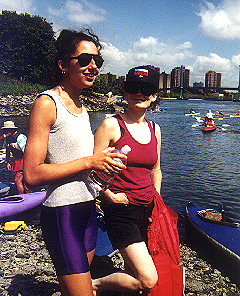
The New York City Parks Department recently opened up several kayak/canoe launches around the city. The Department’s Conditions for Kayak/Canoe Use provides recommendations and identifies potentially hazardous situation in the water surrounding New York City. “You alone are responsible for your own safety and that of your passengers.” Sound advice for all outdoor situations.
Joe Borker, our trip leader, started the trip at the end of Dyckman Street, near Inwood Hill Park on Manhattan. The boat launch--located on the Hudson River, a mile and a half north of the George Washington Bridge--was the site of a discontinued ferry to Englewood Cliffs, New Jersey. Now this small beach, partially blocked by a dilapidated pier, is an official NYC boat launch site. Joe had scheduled our trip to start at 9:00 AM on Sunday July 1st.
Of the twenty boats expected for the trip, eight (including my craft) were Klepper Folding Kayaks. The owners of these Kleppers arrived at 8:00 in order to assemble their boats-in-a-bag by 9:00. The currents around Manhattan alternate directions every five to seven hours. The Hudson River, on Manhattan’s west side has tidal currents ranging from two nautical miles per hour (or Knots) upstream to three knots downstream. The East River (named for its position relative to Manhattan) is actually a tidal strait between Long Island Sound and New York Bay. Here tidal currents can range between three and five knots in either direction, as the East River siphons water into or out of Long Island Sound. Since the average cruising speed for a kayak is three to four knots, knowing the timing of the currents is critical to the success of any trip around New York.
The harbor’s tidal cycle had a direct influence on the location and timing of our launch. We planned to catch the outgoing tidal current going down along the Hudson River in the morning, then catch the incoming tidal current coming up the East River in the afternoon, taking advantage of a favorable tidal push along ninety percent of our route.
“This is the most dangerous part of our trip.
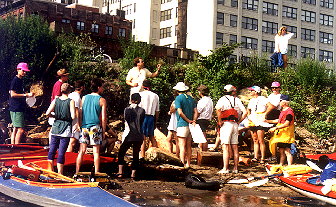
Just before starting, all twenty boats were lined up along the small beach. One canoeist, a true commuter, read The New York Times while waiting for everyone to get ready. Joe, standing on the pier, gave the pre-trip briefing. At first, it seemed a typical pre-trip briefing. Then he distributed maps of the harbor near New York’s southern tip.
“This is the most dangerous part of our trip. Between the Battery and the Brooklyn Bridge, the harbor traffic is most congested. There are tour boats departing from South Street Seaport. The Staten Island Ferry departs every ten minutes, stopping for no one. It’ll be important to stay close together and watch out for the traffic.” Traffic? Now that was something I hadn’t worried about on Lake Umbagog. Joe continued, “We’ll be having lunch on Governors Island, courtesy of the Coast Guard. This should give us a break from being in our boats all day.”
On the back of the first map was another. This map showed where the East River met Long Island Sound. The location? Hell Gate! This name was not selected by chance. “At Hell Gate, we could face the strongest currents of our trip,” said Joe. “As long as we stay close to the Manhattan shore, there shouldn’t be much danger of being sucked out into the Sound.” Joe couldn’t have provided a better motivation for paying attention. Being “sucked out into the Sound” was never a concern on Umbagog. This trip was going to be different.
Because of the importance of sticking to the schedule of currents, our brightly colored fleet of seventeen kayaks and three canoes slipped into the gray Hudson on time. Overhead, the sky was cloudy and there was almost no wind. We waited for all boats to launch before turning south toward the George Washington Bridge, known to commuters as the GWB.
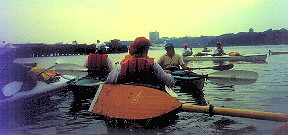
As we floated underneath the bridge, we saw the Jeffery Point Lighthouse, directly under the bridge and to our left. Hildegarde Swift wrote about both in her children’s story, The Little Red Lighthouse and the Great Gray Bridge. She wrote, “Beside the towering gray bridge the lighthouse still bravely stands. Though it knows now that it is little, it is still VERY, VERY PROUD.” I had not seen this lighthouse before, but for a moment, because of this book, this kayak trip became a return visit to a childhood memory.
"Paddling right up to the sides of these ships, we were able to touch them, an intimacy not achieved from land."
Our guidebook for planning this trip was the Eldridge Tide and Pilot Book. Eldridge contains tide and current tables from Nova Scotia to Key West; current charts for Boston Harbor, Long Island Sound, Chesapeake Bay; lights and fog signals; ferry information; and other useful data for mariners. Eldridge predicted low tide at the Battery at 10:18 AM, followed by high tide at 4:31 P.M. Eldridge also contains twelve charts covering hour by hour the entire New York Harbor tidal cycle. We glided by the 79th Street Yacht Basin at about 10:30 A.M. with a favorable current of 2.8 knots.
The New York Times that morning provided the following forecast: “Low pressure forming east of Atlantic City will pull cooler air south into the metropolitan area today. Winds from the northeast will cause extensive low clouds. Potent thunderstorms rumbling through the Middle Atlantic State will signal the arrival of cooler, drier air today. A powerful jet stream disturbance plunging southeast will form thunderstorms with damaging winds , lightning and hail from Carolinas to New Jersey.” Clouds still covered the sky, but we were beginning to see the sun breaking through.
Our first destination was Pier 88, home of the USS Intrepid Sea, Air and Space Museum at 46th Street. The USS Intrepid, an aircraft carrier from World War II, provides a focal point for an expanding museum on the Hudson. Other ships recently added include the submarine USS Growler and the destroyer USS Edison. We left the Hudson’s current and glided between the piers. Paddling right up to the sides of these ships, we were able to touch them, an intimacy not achieved from land. We spoke with several of the museum’s employees on the vessels. The crew seemed intrigued by our kayaks, half expecting one of us to flip over accidentally. We did not oblige.
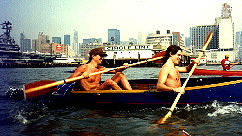
As we paddled back into the current, we were swept past the Circle Line Pier. As the day progressed, our troupe would be passed many times by Circle Line ships. In fact, our flotilla became part of the tour guide’s monologue: “To our left, ladies and gentlemen, you’ll see a group of kayakers enjoying the waters around New York Harbor. And to our right...”
Heading due south, we crossed the Hudson diagonally over to the New Jersey side. The river here is only one-half mile wide. There was not yet much river traffic. It was still Sunday morning. Nevertheless, we did not want to linger long in the main shipping channel. As we paddled across the Hudson, the sun broke out of the clouds. The sky cleared quickly.
"Industry around New York Harbor is on the wane."
We arrived at the New Jersey shore near the Maxwell House Coffee Plant. The well-known giant cup still drips its coffee. Jus a few weeks before our trip, Maxwell House had announced the closing of this plant, one of the last industrial plants on the harbor. We also paddled past the site of the Colgate-Palmolive factory in Jersey City. This plant, too, had closed a few years ago. Only the plant’s famous octagonal clock remains.
Industry around New York Harbor is on the wane. What remains includes the pilings of the old wharfs, old photographs, and movies reflecting an earlier life on the waterfront. What has also gone is much of the pollution manufacturing contributed to the harbor. Although still a problem, harbor pollution has decreased over the past twenty years. I was surprised by the cleanliness of the water that we paddled through. I had almost expected acid would eat through my kayak. In fact, except for a few stretches of the Harlem River, I saw very little floating debris and was not overwhelmed with any smell. With newly constructed sewage treatment plants, water skimmers and the harbor’s natural tidal cleansing cycle, I found it a pleasure to be out on the waters of the harbor.
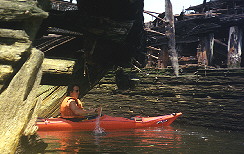
As we passed Ellis Island, we paddled through the annual Liberty Cup Race just before the race gun sounded. We tried to keep our flotilla close together to allow other boats a chance to navigate easily around us.
We paddled over to Liberty Island and the Statue of Liberty. Emma Lazarus, in her well-known poem, described the statue as “A mighty woman with a torch; whose flame is the imprisoned lightning.” From our kayaks just offshore, we had a choice position for viewing the statue.
"I was surprised by the cleanliness of the water that we paddled through."
After which, we plowed our paddles back into the water to cross the harbor to Governors island. This island, used by the Coast Guard, is not accessible to the general public. Somehow, Joe had made arrangements with the Coast Guard to allow us to dock our boats, get out and have lunch. I’m not sure how he had obtained this favor, but it was appreciated by all on the trip. On the way over to the island, we managed to dodge the Staten Island ferry twice as it shuttled between the Battery and Staten Island.
The Coast Guard has a small harbor on Governors Island, a harbor now teeming with our group’s kayaks. We lunched in a park on the island’s north side, overlooking Manhattan’s Battery. It felt good to get out of our boats. More important, we were allowed to use the head on the island. I did not want to think about our options had we been trapped in our kayaks for nine hours without this break.
"There was no place for us to hide. If we stopped to wait out the storm, the currents would turn us around, making the passage up the East River inpossible."
"There was no place for us to hide. If we stopped to wait out the storm, the currents would turn us around, making the passage up the East River impossible."

After an hour, we launched our boats again, this time heading up the East River to the South Street Seaport. It was now 2:00 PM. Every power boat in the harbor seemed to converge here as we began paddling across. But our colorful flotilla, heeding our trip leader’s advice, stayed together as we paddled toward Manhattan under the bright sun. We waved to the people sunning themselves on the Seaport’s pier.
We followed the Manhattan side of the East River underneath the Brooklyn and Manhattan bridges.
"As we passed a docked prison barge, the inmates shouted down encouragement. “Paddle harder! Go, boys, go! Pull! Faster, Faster!”
The breeze, sliding easily over the water, touched the waves reflecting the brilliant sunshine of the early afternoon. That balance of cold and warmth, so rarely attained in outdoor activity, was realized today. To the northeast, we watched distant clouds -- towers of ivory cream --ascending into an endless blue sky.
Giovanni de Verrazano, an Italian employed by the French, was the first white man to lay eyes on Manhattan in 1524. He had gone up “a very great river,” intending to explore the island. However, a sudden storm discouraged the exploration. As we passed the Williamsburg Bridge and turned the corner of the East River, the United Nations Building came into view. Right behind it, we saw the approaching thunderstorm. Now, I understood clearly how Verrazano might have been discouraged 467 years ago.
"There was no place for us to hide."
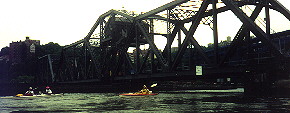
If we stopped to wait out the storm, the currents would turn us around, making the passage up the East River impossible. There were several landing places around Manhattan where we could pull out, fold up our kayaks and take a taxi back to Dyckman Street. The storm did not look that bad. Our trip leader, who knew the harbor well, decided to keep going as the rain started falling.
"The storm hit with full ferocity as we paddled under the Queensboro Bridge, first rain, then hail, then heavy winds blasting directly in our faces."
Visibility decreased to 100 feet. We kept Manhattan on our left, but lost sight of Roosevelt Island on our right. The current swept us north at four knots. We had to keep paddling to stay in control. We dodged around construction barges tied up to shore. We dodged buoys anchored in the river. A tugboat passed somewhere off to our right, sounding its whistle. All the while lightning flashed, followed by close thunder. The rumbling echoed between the skyscrapers around us. Our flotilla split into two groups which lost sight of each other in the storm. Five boats, including mine, paddled ahead together. The rest rafted their boats together as an extra safety precaution.
"Suddenly, as I pulled back hard, my wooden paddle broke in two."
Fortunately, I had remembered to bring a spare paddle. What could have been a crisis was instead only a momentary inconvenience.
Someone who did not know sea kayaks would have thought we were in a dangerous plight. The situation was demanding, but both proper training and equipment helped to reduce our risk in the storm. The trip leadership was informed and the boats were truly seaworthy.
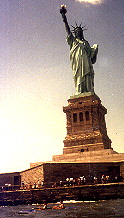
A New York Times article of the following day said the Liberty Cup was halted yesterday afternoon after the event was cut short by a severe thunderstorm with thirty-five-mile-an-hour winds that sent most of the traffic in New York Harbor scurrying for shore.
We had weathered the storm and regrouped past Hell Gate at about 5:00 PM. A New York Fire Department Boat pulled alongside us, saying, “You guys had everyone on this side of Manhattan worried.” We assured them we were fine.
The Harlem River was the last leg of our trip, and the six miles went by slowly and uneventfully. At the northern tip of Manhattan, we paddled past Columbia’s boat docks. With the verdant fields and forests here, it was hard to believe the World Trade Towers were at the other end of this same island.
We paddled back onto the Hudson River through Spuyten Duyvil. After our East River experience, the Hudson seemed like an old friend. We beached our boats at Dyckman Street at 7:00 PM, ten hours after starting our circumnavigation.
Mark Winkler is an experienced Hiker and Kayaker.
Winkler lives with his wife and daughter in Pleasantville, New York.
'A Salty Dog Index'
MAIN PAGE
FEATURES PAGE
HOME
| GADABOUT GADDIS | KAYAK
NAVIGATION | FREE KAYAKING
IN NEW YORK CITY
KAYAK STORIES | COLD
WATER WORKSHOP | OUTSIDE
LINKS | STOP SMOKING NOW
FREE HYPNOSIS PRACTICE GROUPS | HYPNOSIS,
HYPNOTHERAPY, SELF HELP DIRECTORY
THE HYPNOSIS CENTER LLC |
SELF HELP TESTIMONIALS
FRIENDS OF OURS !!
STOP
ALCOHOL WITH NYC HYPNOSIS | SPIRIT
POSSESSION | HYPNOSIS NYC CERTIFICATION
TRAINING |
BANGKOK AND THAILAND TRIPS |
STOP SMOKING WITH NYC HYPNOSIS | GREENWICH
VILLAGE RESIDENTS - NEW YORK |
HYPNOSIS MARKETING NEWS
| HYPNOSIS NEW YORK |
HYPNOSIS NYC |
HYPNOSIS STAGE NY |
HYPNOTIST NEW YORK NOTEBOOK
| THE MAD RUSSIAN | MAD
RUSSIAN HYPNOSIS | SILVA
MIND CONTROL GRADUATES
QUIT SMOKING HYPNOSIS
NYC | LOSE
WEIGHT HYPNOTHERAPY NEW YORK | HYPNOSIS
CDS | HYPNOSIS
BOOKS
NEW YORK HYPNOSIS MARKETING
NEWS | HYPNOSIS NYC
CERTIFICATIONS